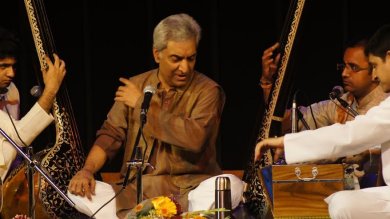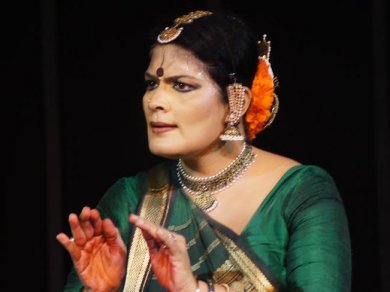
|   |

|   |
Spring in the air and in the arts - Shveta Arora e-mail: shwetananoop@gmail.com Photos: Anoop Arora May 6, 2015 The spring in Delhi is a little prolonged this year as the rains have not let the temperature rise. The flowers in the foyer at Stein Auditorium at IHC enhanced the pleasant ambience of spring. The occasion was Sur Shringar - a festival organized by Yogdan, an NGO which provides livelihood and education to the underprivileged. The artistes of the evening, Madhup Mudgal and Geeta Chandran are masters of their craft and proved that despite performing in front of a packed house, their immersion in their performances and its selfless pleasure is complete.  Pt Madhup Mudgal
Pt Madhup Mudgal, a Hindustani classical music vocalist, began with “Devo daan mohe,” a composition in raga Yaman Kalyan. This composition was his guru Kumar Gandharva’s, to whom it was a tribute on his 95th birth anniversary. He sang “Kinare kinare dariya,” “Kaun tum he batlao,” and “Ae ri mai jaane na doongi.” He ended his recital with a thumri in Behaag. With his excellent voice control and modulations, he had the audience enthralled. Geeta Chandran began her performance with a Govinda vandana. The piece was based on a composition by the haveli sangeet poet Hita Hari Vallabha in ragamalika and talamalika, an ode to Lord Vishnu, and enshrines the concept of Sanatana - one in many, many in one. It elaborated on the different aspects of Krishna’s life based on the Bhagavata Purana. Geeta portrayed the four-armed posture of Lord Vishnu with gadaa, padma, shankh and chakra. The lyrics are beautifully synthesized so that words with similar prefixes are juxtaposed - vishvaroopaye vishvakaaye (He embodies the universe), kamalanabhaye (lotus emerging from his navel), kamalapati (goddess Laxmi’s husband). Geeta depicted the reclining posture of the Lord on the sheshnag with Laxmi caressing his feet, the lotus emanating from his navel, the destroyer of demons like Kansa, Keshi and Chanur, and the charioteer of Arjuna (Parthasarthaye namah). He is the cowherd of Vrindavana (Venugopal), with the cows listening spellbound to his flute, as he roams the banks of the Yamuna, his ear ornaments brushing his cheeks. He is the husband of Rukmini and the lover of gopis. And finally, he is the jagat guru who takes you across the sea of worldly mirage.  The next piece was Shringara Vaibhavam. In the season of spring, when love is in the air, shringara becomes the king of all emotions. The choreography began with a canto from Damodara Gupta’s Kuttinimuttam. With fluttering sensuous movements of the hands Geeta depicted Kamadeva as the bee who kisses the face of his consort, which is like a flower with a thousand petals. It is not only humans but also the birds and animals which get affected by Kamadeva’s arrows. This invocation of Kamadeva was followed by two verses from Kalidasa’s Ritusamhara, sixth canto. Here the lyrics and the dance described Vasant as the warrior or Vasant Yodha (warrior Vasant) for the season. Mango blossoms are his sharp arrows, bees in rows his humming bowstring. Trees (dhrum) laden with flowers (pushp), water (salilam) abounding with lotuses, the air sweetly scented (pawansugandha) - this is what the days are like and the twilight (pradoshakaal) is very pleasant. While the entire creation - flowers, birds, animals - are enjoying their union, the hero and heroine hang up a swing on a tree. The heroine swings up while the hero pushes her swing higher. This was an aesthetically presented piece with spellbinding footwork and facial expressions. The showstopper for the evening was about how women can gossip and talk maliciously about each other. Elaborating on the piece, Geeta depicted a sakhi inviting her friends for a game of dice. It is then that they start gossiping about one of them rushing out to meet Krishna. This nayika does not bother about shame or dignity, which are all thrown to the wind. She is not perturbed by what her in-laws would say. So immersed is she in her ecstasy of meeting him that the pallu of her sari is falling off her shoulders. It was wonderful to see how Geeta could transform herself to a village woman ‘bitching’ about another. About the piece, Geeta said, “Choodare is a well-known padam in Bharatanatyam from composer Kshetrayya in ragam Sahana. It is an unusual piece in that it showcases gossip, a common failing. I was taught this padam by the doyenne of abhinaya, Kalanidhi Narayanan. The narrative shows a group of women spying on a neighbour's daughter-in-law jauntily running on the street to meet her lover Krishna. They stop her and probe where she is off to. To their surprise, she openly tells them that she is off to her tryst with Krishna. Stunned by her boldness, they launch on a detailed character assassination saying that despite belonging to one of the best families of the community, look where she is taking their reputation. Without a care for the way she looks, with exposed breast and a sprightly walk, she breaks all taboos in her eagerness to meet Krishna. They finally surmise that no one can fight fate, and probably she was only acting out her destiny. The undertone of humour in the padam was never abandoned.” “Natanam aadinar” in ragam Vasantha, a composition by poet Gopalakrishna Bharathi, describes the dance of Nataraja in the golden hall at Chidambaram. The dance is so powerful that the earth shakes with its energy. Geeta did some well-balanced cross-legged lift stances and stances of Shiva with snakes and damaru. She portrayed the eight directions (ashtadisha), creatures on land, in water and in the sky, gazing with reverence and astonishment. She ended the performance with the ever-enchanting sankirtan. Accompanying her were G Raghuraman (flute), MV Chandrashekhar (mridangam), Sudha Raghuraman (vocals) and Guru S Shanker (nattuvangam). Shveta Arora is a blogger based in Delhi. She writes about cultural events in the capital. |